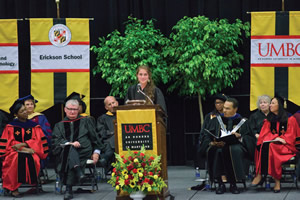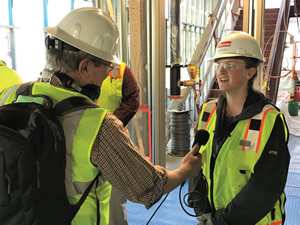STEM Equality
- By Stephen Ceasar
- 10/01/18
College and universities have long struggled to enroll and graduate women in the science, technology, engineering, and math fields (STEM), an issue that has led to innovative and successful programs in recent years aimed at actively recruiting, enrolling, and graduating women into the STEM workforce.
Despite these gains, women are still far outpaced by their male peers in the so-called “hard sciences” of engineering, computer science, and others. In 2016, women earned just 21 percent of engineering degrees (a three percent increase since 2006) and 19 percent of computer science degrees (a one percent decrease since 2006).
That disparity continues in the workforce, where women often enter the socalled “helping professions” within the larger STEM umbrella. According to a Pew Research Center report, women make up a majority of those working in health-related occupations, for instance, but make up only 14 percent of engineering jobs within the field. Women make up only eight percent of mechanical engineers and seven percent of sales engineers, the report found.
That disparity has prompted some colleges to reimagine their recruitment efforts and programs, crafting them in ways that work to dispel the notion that these fields and industries are unwelcoming for women. They are doing so by creating supportive communities of peers, faculty, and staff, and by helping women leverage their skills and sensibilities into success in traditionally male-dominated arenas.
How the Pieces Fit Together In sixth grade, Julianna Posey learned to knit. She took to it immediately, reveling for hours in every pattern, obsessing over each new skill she learned and feeling proud of her complex designs.
The hobby continued into her senior year of high school, a time when she was constantly fretting about what she would study in college. One day her father asked her to help him change a fuel injector on their 1996 Chevy Suburban. He taught her how the pieces worked together and how to fix it. The work felt very familiar.
“It was just like knitting,” Posey says. “It took analysis and a step-by-step process to make it work. I was using my hands and my creativity.”
She found her calling.
A friend told her about the University of Maryland, Baltimore County’s Center for Women in Technology (UMBC, cwit.umbc.edu), which offers a Scholars Program aimed at nurturing a strong group of women in science through an inclusive environment, financial support, mentorship, and a supportive living-learning community.
UMBC offered a generous scholarship, removing a barrier to her attending, and Posey enrolled as a mechanical engineering student. Still, she worried about how she’d be perceived, and if she was going to be able to succeed in such a rigorous program. She attended an orientation for the program and her fears disappeared.

PHOTO © MARLAYNA DEMOND FOR UMBC
BUILDING A COMMUNITY. At the University of Maryland, Baltimore County (UMBC), the Center for Women in Technology (CWIT) helps UMBC to identify those areas in science, technology, and engineering where women are underrepresented, attracts well-qualified female students such as Julianna Posey to UMBC through special scholarship initiatives such as the CWIT Scholars Program, and works with departments and other campus partners to help make UMBC a welcoming place for women in engineering and information technology.
“I felt right at home,” she says.
The program is designed to lessen the isolation that many women feel in a space where there are often only a handful of women in a classroom or at a job site.
“There is community that is there for you, a group where you can go and talk to other women who are experiencing the same thing you are,” Posey says.
Students in the Scholars Program graduate a higher rate than their peers at UMBC with identical socioeconomic status and high school qualifications, according to a study conducted by the university.
Erica D’Eramo, the assistant director for the Center for Women in Technology, says that college administrators and faculty must first acknowledge past failures in supporting women in STEM before any progress can be made. Then they must take the lead.
“We cannot do this work alone—we need our allies, we need voices around the table who get it and are able to support women and advocate for women’s rights in a different way than women are currently able to do on their own,” D’Eramo says.
The best assets in recruitment have proven to be the women scholars themselves.
“We send our students out to these schools to share their passion, to show young women there that they can do this too,” she says.
Building Something That Lasts
Shannon Sturtz had decided to study applied mathematics at Wentworth Institute of Technology in Boston, but a summer on a Massachusetts work site with her father and talks with her mother made her realize a future in the family trade of construction was more in line with her interests and goals.
“I didn’t want to work behind a desk all day,” she says. “I love how personable it is. You can help people. You build something that lasts for so long.”
Sturtz benefited from having a window inside an industry that may seem unwelcoming to women.

PHOTO © WENTWORTH INSTITUTE OF TECHNOLOGY
WOMEN AT WORK. A unique project underway on the campus of Wentworth Institute of Technology (WIT) is WIT’s first new academic facility in more than 40 years. More than just a new structure, the project is designed as a strategic opportunity to help develop the next generation of construction professionals. Partnering with Gilbane, WIT is using the project to create a significant hand-on learning experience for its construction management students, including Shannon Sturtz.
“If I didn’t have my mom, I don’t think I would have even known it was a possibility,” Sturtz says. “Just because you’re in construction management doesn’t mean you’re swinging a hammer.”
It is a perception that Scott Sumner, chair of the Construction Management Department at Wentworth, is constantly battling.
Five years ago, only five percent of the construction management department was comprised of women, prompting Sumner to set out to convince prospective students that the construction industry was an accepting profession that would treat them well, and that a rewarding, lucrative career awaited those who persisted.
“It is true. Construction as a profession has been dominated by males, mainly white males,” he says. “We’re changing that.”
But good messaging is nothing without follow-through, Sumner says. The school offered no scholarships for women and had no way to get them through the door. The school worked with industry partners to establish scholarships specifically aimed at women in construction management that increase each year of attendance. The structured approach has led to results.
The school more than doubled the number of women in their program from five percent in 2013 to 12 percent today. Each graduate has an exponential effect on recruitment. “We have our women graduates talk to the incoming students; it makes it a better entry to this world for them so that they don’t feel quite as concerned,” Summer explains.
There is still much work to be done, as decades of a skewed perception lingers on.
“We absolutely have to dispel of the notion that construction is unwelcoming to women,” he says. “Maybe it was, but it’s not true any longer. Things change.”
This article originally appeared in the College Planning & Management October 2018 issue of Spaces4Learning.